The Dangers in Climbing Mountains
The danger in mountaineering comes in two varieties: subjective and objective. Subjective danger you have some control over, such as screwing the ice piton in correctly so it holds you. I once owed my life to an ice piton that was screwed in just one inch on thin ice on a Himalayan face that plummeted down to a glaciated valley never visited at the time (1965) and from which rescue was impossible. I was leading a difficult pitch (the name given to one rope-length of climbing) when I slipped, fell and pulled my companion off his stance. The piton held us both and we dangled for a few minutes before extricating ourselves.
Ascent Of A Mountain |
|
No ascent in the big mountains can begin without a “poojah”, a Bhuddist ceremony to appease the gods and pray for favorable conditions. The ceremony is led by a lhama, in this case one of our three Sherpas. Sherpas are men from the area who are super-adapted to high altitude and help find the trail and carry loads up the mountain. |
|
The path from basecamp to camp 1 led along the glacier and then up a steep slope to 6400 m. |
|
Climbing above camp 1 |
|
Approaching the ice cliffs. |
|
At the ice cliffs |
|
|
|
Camp 2 at 7000 m. The dry landscape to the right is the Tibetan plateau to the north. |
Ascent of a MountainContinue to part 3 |
Objective danger is the variety you usually have no influence over. This includes falling rocks, avalanches, lightening strikes, etc. Experience minimizes these risks, but they never disappear. Seven years after the piton dangling episode, I returned to the same Himalayan peak, still unclimbed, got trapped on one of its sharp ridges and was struck by lightening. By luck, the bolt hit the ridge some distance from the party, so all we suffered was the feeling of having 110 volts momentarily pressed to our backsides.
The stress of continually climbing with high objective danger can build up. I was once leading my childhood climbing mentor (a teacher, not my father) and a friend up the Zmutt ridge on the Matterhorn. It’s a difficult route, and I had romped up it in perfect conditions three years earlier with two companions unroped. This time it was covered in snow and ice and in a lethal condition. We had progressed to a point when retreat would have been more dangerous than continuing, frequently the case in technical climbing. We then embarked on a lengthy and obligatory section on the East face of the mountain. There was no protection in case of a fall and we ascended gingerly for 500 meters before regaining the ridge. One slip would have brought us all down. At the ridge, I saw a piton firmly anchored in a crack and I immediately snapped into it to offer protection. I burst into tears with relief.
That ascent of the Matterhorn was so slow we ended by sleeping just below the summit. You have to get used to sleeping in strange places. I’ve slept in my rucksack, an extendable type that accommodates my legs, pinned to a Himalaya peak at 6000m. I’ve slept on an ice ledge just below a virgin Hindu Kush peak in Afghanistan just climbed. I’ve slept half way up the Frendo spur in winter during a blizzard, a climb on the north face of the Aiguille du Midi in the Chamonix valley. I’ve slept in the open for three weeks crossing the Afghan foothills where the air is so clear you see satellites passing. Often I’ve failed to sleep because of the anticipation of a hard climb. In the Alps and before summit attempts in the Himalayas, you anyway never have long to sleep because you must use the early hours when the snow is hard.
Sometimes when you sleep at altitude, the brain gets fooled by the low atmospheric pressure and stops signaling the body to breathe. The technical term is Cheyne-Stokes breathing. Three years ago, I took my family trekking in the high Karakoram in north-west Pakistan where that country meets India and China. We had been walking a week and were camped at 5000m beneath a glittering array of peaks and glaciers. That night, my wife awoke and realized she had stopped breathing. She scrambled out of the tent into the freezing darkness to get air and sat for 30 minutes gradually catching her breathe. The following night, I had a similar attack.
Cheyne-Stokes doesn’t kill, but two other tricks that altitude plays on the human body do, and quickly. For reasons not entirely understood, the reduced air pressure can suddenly release large amounts of water in the body, either filling the lungs causing death by internal drowning (pulmonary oedema) or filling the brain with similar results (cerebral oedema). Both happen unpredictably and can finish you in less than 24 hours. Special medicines delay death, but the only real hope is to descend to lower altitudes where symptoms usually disappear. The oedemas strike experienced and novice climbers alike. Fitness has nothing to do with it. The fact that you’ve ascended high, even several times, is no insurance either.
However, none of this happens to people born and raised in the high mountains. The famous Sherpas, a Nepalese tribe living in the shadow of Mount Everest, have bodies perfectly adapted to altitude. They easily outperform even the most acclimatized climber from lower altitudes. On Cho Oyu I climbed with Norbu who holds the record number ascents of Everest — seven. I struggled every inch of the way, while he frolicked around and chain-smoked his way up the mountain. From birth his lungs have been converting oxygen to red blood cells more efficiently than anyone raised at low altitudes can ever achieve. His whole body is adapted perfectly to life at high altitude.
A solution for lowland mortals is to supplement your breathing artificially with oxygen stored in little bottles that fit in your backpack. Supplementary oxygen makes everything feel about 2000m lower, so Everest’s 8900m altitude becomes 6900m, an easier proposition by far. But no guarantee! If the breathing apparatus freezes up or fails, which is not uncommon, you’re suddenly back at 8900m. The question facing every climber of very high mountains is whether or not to use supplementary oxygen. My decision at the relatively young age of 56 is still to say no. I would rather fail to get up the mountain than depend on artificial anything. Maybe when I’m older I’ll change my mind, but I doubt it.
This content has been re-published with permission from SEED. Copyright © 2025 Schlumberger Excellence in Education Development (SEED), Inc.


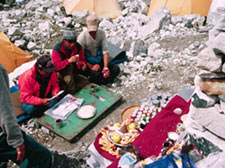
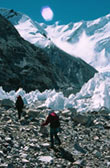
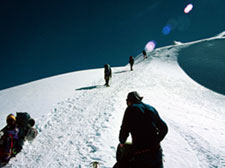
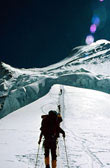
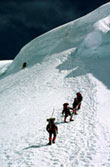
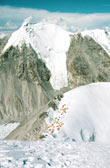 View down to camp 1, the mass of tiny orange dots. We are beginning to get above the neighbouring peaks.
View down to camp 1, the mass of tiny orange dots. We are beginning to get above the neighbouring peaks.